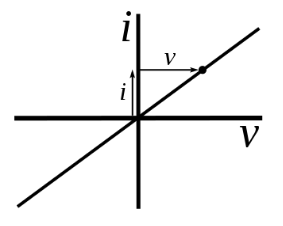
What is Ohm's Law graph?
Answer
495.3k+ views
Hint:The rule was named after German physicist Georg Ohm, who reported measurements of applied voltage and current via basic electrical circuits comprising varying lengths of wire in a book published in 1827. Ohm's experimental results were described by a somewhat more complicated equation than the current one above.
Complete answer:
According to Ohm's law, the current flowing through a conductor between two locations is proportional to the voltage across the conductor. When the proportionality constant, resistance, is included, the typical mathematical equation that explains this connection emerges:
\[I = \dfrac{V}{R}\]
where $I$ is the current through the conductor in amperes, $V$ is the voltage measured across the conductor in volts, and R is the conductor's resistance in ohms. Ohm's law indicates that the $R$ in this relationship remains constant regardless of the current.
The above equation cannot be termed Ohm's law if the resistance is not constant, but it may still be used to define static/DC resistance. The conductivity of the great majority of electrically conductive materials is properly described by Ohm's law across several orders of magnitude of current.
Non-ohmic materials, on the other hand, do not follow Ohm's law.When a conductor is kept at a constant temperature, Ohm's Law states that the current flowing through it is proportional to the voltage across it. This means that if we plot voltage on the x-axis and current on the y-axis of a graph, the result will be a straight line. The resistance of the conductor is linked to the gradient of the straight-line graph as \[\dfrac{I}{V} = \dfrac{1}{R}.\]

Note:For most materials, Ohm's law is an empirical law, a generalisation of numerous experiments that have demonstrated that current is roughly proportional to electric field. It is not usually followed and is less basic than Maxwell's equations. Under a high enough electric field, any material will break down, and some materials of importance in electrical engineering are "non-ohmic" under weak fields.
Complete answer:
According to Ohm's law, the current flowing through a conductor between two locations is proportional to the voltage across the conductor. When the proportionality constant, resistance, is included, the typical mathematical equation that explains this connection emerges:
\[I = \dfrac{V}{R}\]
where $I$ is the current through the conductor in amperes, $V$ is the voltage measured across the conductor in volts, and R is the conductor's resistance in ohms. Ohm's law indicates that the $R$ in this relationship remains constant regardless of the current.
The above equation cannot be termed Ohm's law if the resistance is not constant, but it may still be used to define static/DC resistance. The conductivity of the great majority of electrically conductive materials is properly described by Ohm's law across several orders of magnitude of current.
Non-ohmic materials, on the other hand, do not follow Ohm's law.When a conductor is kept at a constant temperature, Ohm's Law states that the current flowing through it is proportional to the voltage across it. This means that if we plot voltage on the x-axis and current on the y-axis of a graph, the result will be a straight line. The resistance of the conductor is linked to the gradient of the straight-line graph as \[\dfrac{I}{V} = \dfrac{1}{R}.\]

Note:For most materials, Ohm's law is an empirical law, a generalisation of numerous experiments that have demonstrated that current is roughly proportional to electric field. It is not usually followed and is less basic than Maxwell's equations. Under a high enough electric field, any material will break down, and some materials of importance in electrical engineering are "non-ohmic" under weak fields.
Recently Updated Pages
Master Class 10 General Knowledge: Engaging Questions & Answers for Success

Master Class 10 Science: Engaging Questions & Answers for Success

Master Class 10 Social Science: Engaging Questions & Answers for Success

Master Class 10 Maths: Engaging Questions & Answers for Success

Master Class 10 English: Engaging Questions & Answers for Success

Master Class 10 Computer Science: Engaging Questions & Answers for Success

Trending doubts
The shortest day of the year in India

Why is there a time difference of about 5 hours between class 10 social science CBSE

Write a letter to the principal requesting him to grant class 10 english CBSE

What is the median of the first 10 natural numbers class 10 maths CBSE

The Equation xxx + 2 is Satisfied when x is Equal to Class 10 Maths

State and prove converse of BPT Basic Proportionality class 10 maths CBSE




